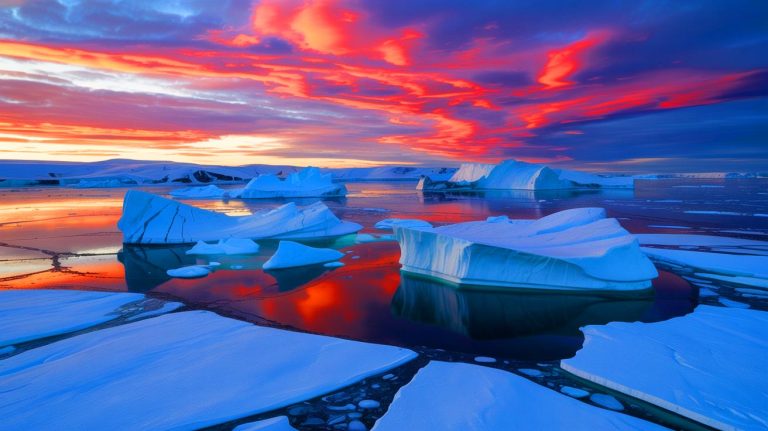| IN A NUTSHELL |
|
The alarming decline in global sea ice has reached a significant milestone, with both Arctic and Antarctic regions witnessing record-low ice levels. This trend, observed over several decades, has raised serious concerns among scientists about the future of our planet’s climate. As these icy realms shrink, the implications for global weather patterns, sea levels, and ecosystems are becoming increasingly dire. This article delves into the recent findings, highlighting the critical importance of understanding and addressing this ongoing environmental challenge.
Record Low in Arctic Winter Sea Ice
On March 22, 2025, the Arctic winter sea ice reached an unprecedented low at its annual peak, marking a continuation of a worrying decline. According to NASA and the National Snow and Ice Data Center (NSIDC), the ice extent peaked at 5.53 million square miles, setting a new record below the previous low in 2017. This reduction underscores a decades-long trend of diminishing sea ice in the Arctic, where the accumulation of multi-year ice has significantly decreased. The 2025 maximum was notably 510,000 square miles below the 1981–2010 average, illustrating the challenges posed by climate change and its impact on the Arctic environment.
The Arctic’s frigid winter months typically see an expansion in sea ice. However, recent years have shown a disturbing pattern of reduced ice formation. With less new ice developing and a decrease in multi-year ice, the Arctic is experiencing a transformation that could have far-reaching effects on global climate systems. This decline in sea ice not only affects local ecosystems but also influences weather patterns across the Northern Hemisphere.
Antarctic Ice Decline and Global Implications
In the Antarctic, the situation mirrors the Arctic’s plight. During the summer of 2025, Antarctic sea ice retreated to 764,000 square miles by March 1, tying for the second lowest recorded minimum. This level is approximately 30% below the pre-2010 average, highlighting a significant shift in Antarctic ice conditions. The measurement of sea ice extent, defined as the area with at least 15% ice concentration, provides a stark reminder of the changes underway at the poles.
The reduction in Antarctic ice has profound implications for global sea levels and marine ecosystems. As the ice diminishes, the stability of ice shelves is compromised, potentially leading to increased melting of land-based ice and subsequent sea-level rise. This alarming trend necessitates urgent attention to understand and mitigate the impacts of a warming planet on these crucial icy environments.
Consequences and Monitoring Challenges
The cumulative effect of diminishing ice in both polar regions has led to an all-time low in global sea ice coverage. In mid-February 2025, global ice coverage fell by over a million square miles compared to the pre-2010 average. This reduction in ice is equivalent to an area large enough to cover the entire eastern United States. The lack of sea ice has significant implications for the planet’s climate, as the reflective surface of ice plays a crucial role in regulating Earth’s temperature.
Monitoring these changes relies heavily on satellite technology. Instruments aboard satellites in the Defense Meteorological Satellite Program measure Earth’s radiation in the microwave range, distinguishing between open water and ice. This technology allows for consistent, daily observations of sea ice extent, crucial for tracking these alarming trends. However, challenges remain in understanding whether the current conditions in the Southern Hemisphere represent a new norm or a temporary phase.
The Role of Science and Global Awareness
Scientific research and technological advancements play a vital role in understanding the dynamics of sea ice and its broader implications. As highlighted by experts like Linette Boisvert from NASA’s Goddard Space Flight Center, the current trajectory of ice decline “doesn’t bode well for the future.” The data collected through satellite observations and historical records provides invaluable insights into the changing state of our planet’s icy regions.
Public awareness and global cooperation are crucial in addressing the challenges posed by melting sea ice. Initiatives such as the SciTechDaily newsletter aim to keep the public informed about breakthroughs and developments in climate science. Understanding these changes is essential for developing strategies to mitigate their impact and adapt to a rapidly changing environment.
As we confront the reality of shrinking sea ice, the urgent need for action becomes increasingly clear. The implications for global climate, sea levels, and ecosystems are profound, demanding a concerted effort to address and reverse these trends. How will we rise to the challenge of preserving these critical components of our planet’s climate system?
Did you like it? 4.5/5 (30)







Is this really happening, or are we being misled by data manipulation? 🤔
Thank you for bringing this to light. It’s crucial we act quickly to reverse this trend.
How can we be sure that these measurements are accurate?
Another “end of the world” prediction… color me skeptical. 😒
Great article! The urgency is clear, but where do we start?
Can someone explain how this affects my daily life? 🌍
Why does NASA data always seem to point to gloom and doom?
Thanks for the eye-opener! What actions can individuals take to help?